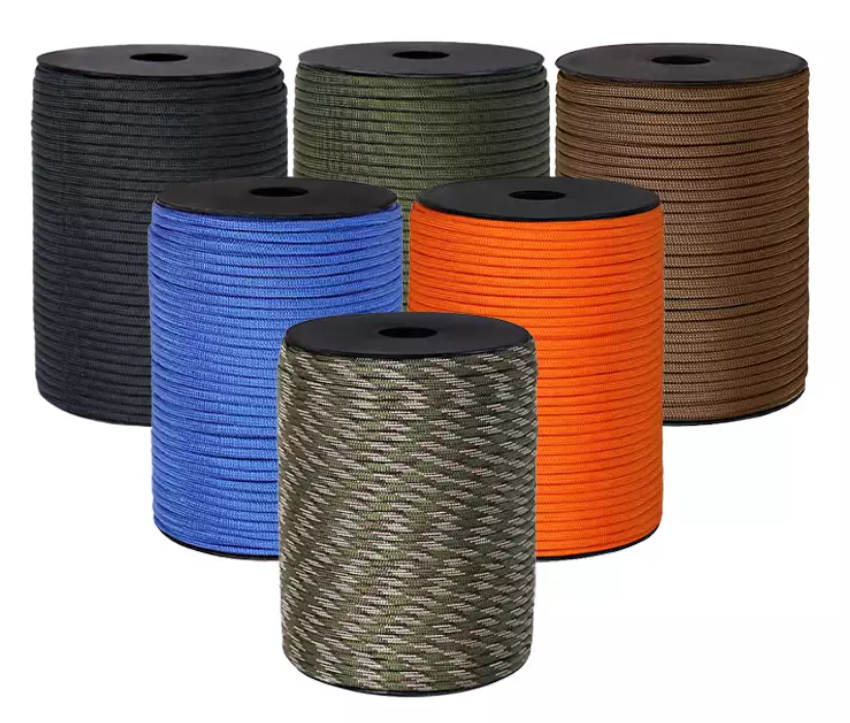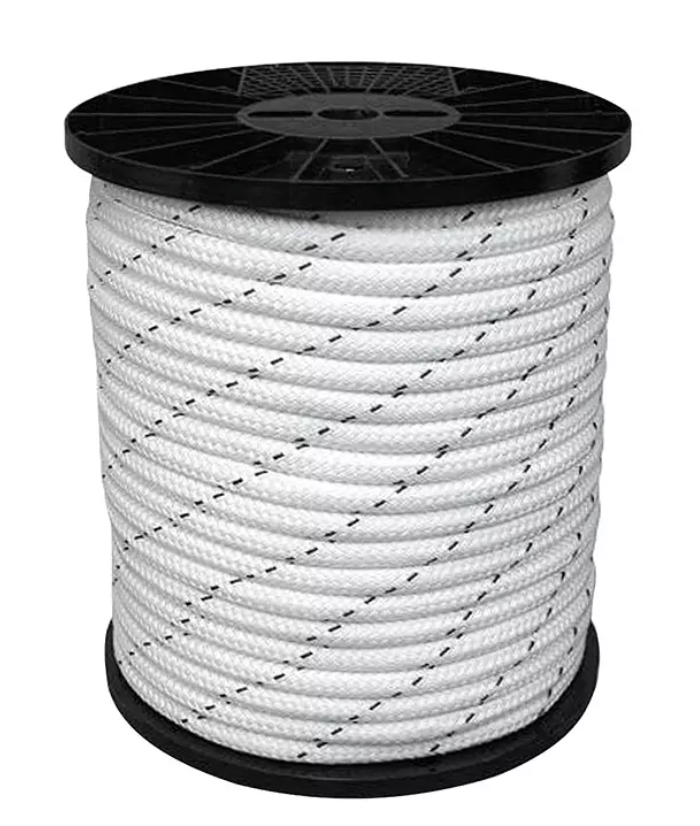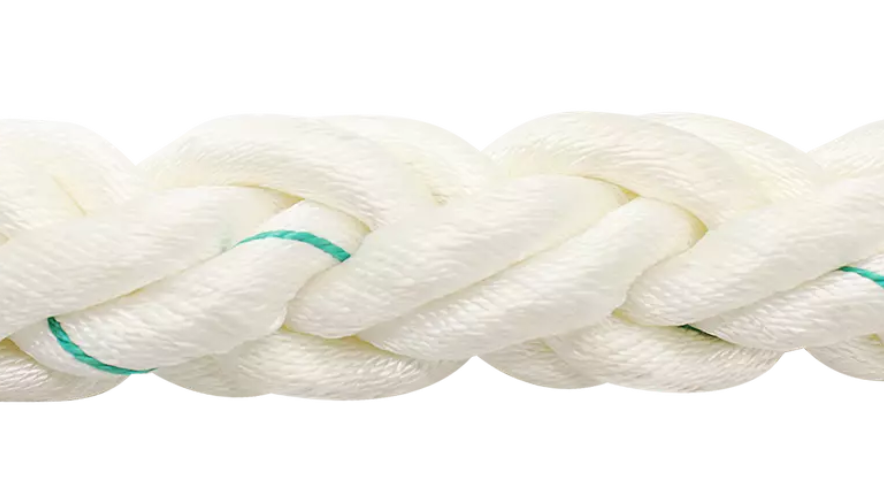Views: 0 Author: Site Editor Publish Time: 2025-08-27 Origin: Site











When it comes to choosing the right rope for a task, understanding the differences between polyethylene (PE) and nylon ropes is crucial. Both types of ropes have unique characteristics that make them suitable for various applications, and being aware of these distinctions can help you make an informed decision.
Nylon rope is made from synthetic polyamide polymers. These polymers are engineered to create long, strong chains of molecules. The manufacturing process of nylon rope often involves extruding molten nylon through dies to form fibers, which are then twisted or braided together. This results in a rope with a relatively smooth texture, and the material has a characteristic sheen. Nylon's molecular structure gives it certain inherent properties, such as high strength and elasticity.
PE rope, on the other hand, is crafted from polyethylene, a polymer made from the monomer ethylene. There are different types of polyethylene used in rope production, including high-density polyethylene (HDPE) and low-density polyethylene (LDPE). HDPE ropes, for example, are known for their greater strength compared to LDPE ropes. PE ropes are produced by melting the polyethylene resin and then forming it into strands through processes like extrusion. The resulting ropes can have a more matte appearance compared to nylon ropes.

Nylon ropes are renowned for their high tensile strength. In fact, nylon is one of the strongest synthetic materials used in rope manufacturing. A well-made nylon rope can withstand significant pulling forces, making it suitable for applications such as heavy-duty towing, lifting in construction, and mooring large boats. For instance, a 3-strand nylon rope of a certain diameter can have a minimum breaking strength that is much higher than ropes made from many natural fibers. Additionally, nylon has good shock-absorbing capabilities due to its elasticity. When a sudden load or shock is applied, the nylon rope can stretch to absorb the energy, reducing the impact on the objects being connected by the rope. However, when nylon rope gets wet, it can experience a slight reduction in strength, typically around 10-15% loss.
PE ropes also offer good strength, especially HDPE ropes. They are designed to handle substantial loads in applications where their specific properties are advantageous. PE ropes have a relatively high strength-to-weight ratio, meaning they can be quite strong while still being lightweight. For example, in marine farming applications, PE ropes are used to support nets and structures because they can withstand the forces exerted by the water and marine life. PE ropes maintain their strength well when wet, which is a significant advantage over some other materials. They also have a lower elongation under load compared to nylon ropes, which means they stretch less when pulled, making them suitable for applications where minimal stretch is required, such as in some industrial rigging scenarios.

Nylon ropes are highly flexible. Their flexibility makes them easy to handle, knot, and manipulate. This characteristic is extremely useful in applications where quick and secure fastening is necessary, like in climbing, where climbers need to be able to tie knots easily and quickly. The smooth surface of nylon rope also reduces friction when it passes through pulleys or around corners, making it efficient for use in pulley systems. However, the high flexibility of nylon can sometimes be a drawback in applications where a stiffer rope is required to maintain a particular shape or structure.
PE ropes are generally stiffer than nylon ropes. While this stiffness can make them a bit more challenging to knot compared to nylon, it also gives them an advantage in applications where a more rigid structure is needed. For example, in some agricultural applications where ropes are used to support structures like trellises, the stiffness of PE ropes helps them maintain their shape and provide stable support. PE ropes are also less likely to kink or tangle compared to more flexible nylon ropes, which can be beneficial in long-term outdoor applications where the rope may be left in place for extended periods.
Nylon ropes have good resistance to abrasion, mildew, and common chemicals. They can withstand rubbing against rough surfaces without quickly fraying, which is important in applications where the rope may come into contact with sharp edges or abrasive materials, such as in industrial settings or during outdoor activities. Nylon also has decent UV resistance, although it is not completely immune to the effects of sunlight over long-term exposure. To improve its UV resistance, some nylon ropes are treated with additives during the manufacturing process. However, as mentioned earlier, nylon can absorb water, which can lead to a small decrease in strength and may cause the rope to sag slightly when wet.

PE ropes are highly resistant to water, rot, and many chemicals. They are virtually impervious to moisture, which makes them ideal for marine and outdoor applications where exposure to water is constant. PE ropes also have excellent UV resistance, which means they can be used outdoors for long periods without significant degradation due to sunlight. Their resistance to chemicals such as acids, alkalis, and oil makes them suitable for industrial applications where they may come into contact with various substances. Additionally, PE ropes have good abrasion resistance, allowing them to withstand rough handling and rubbing against surfaces.
Nylon ropes are generally denser than water, so they sink. This property is important to consider in applications where buoyancy is a factor, such as in some fishing or boating scenarios. If a floating rope is required, nylon may not be the best choice. However, in applications where the rope needs to stay submerged, such as for underwater mooring or in some diving-related activities, its sinking nature can be an advantage.
PE ropes, especially those made from HDPE, are lightweight and buoyant. They float on water, which makes them extremely useful in marine applications like fishing nets, where the buoyancy of the rope helps keep the net in the desired position in the water column. In boating, PE ropes can be used for applications where a floating line is needed, such as for marking channels or as safety lines that are easily visible on the water surface.
Nylon ropes are often more expensive than PE ropes. The cost of nylon rope is influenced by factors such as the quality of the nylon material, the manufacturing process (e.g., braiding or twisting techniques), and any additional treatments or coatings. The higher cost of nylon is due to the more complex manufacturing process of the nylon polymer and its superior strength and performance characteristics in many applications. However, for applications where the unique properties of nylon, such as high strength and shock absorption, are essential, the higher cost may be justified.
PE ropes are generally more cost-effective. The raw material, polyethylene, is relatively inexpensive, and the manufacturing process for PE ropes is often less complex compared to nylon ropes. This makes PE ropes a popular choice for applications where cost is a significant consideration, such as in some agricultural, light-duty industrial, and general household uses. Despite their lower cost, PE ropes still offer good performance in terms of strength, durability, and resistance to environmental factors for many common applications.
Choosing the right rope depends on understanding the specific needs of your application. Nylon rope offers high strength, elasticity, and flexibility, making it ideal for high-stress tasks like towing, climbing, and heavy lifting. On the other hand, PE rope provides excellent resistance to moisture, UV exposure, and chemicals, making it perfect for marine, outdoor, and industrial use where durability and cost-effectiveness are key.
Consider the unique properties of each rope type to ensure you select the best option for your task. Whether you need strength, flexibility, or environmental resistance, both nylon and PE ropes offer valuable benefits for a variety of applications.
A: The main difference lies in the material composition. Nylon rope is made from polyamide polymers, offering high strength and elasticity, while PE rope is made from polyethylene, known for its light weight and resistance to moisture, UV exposure, and chemicals.
A: Yes, nylon rope typically has a higher tensile strength, making it more suitable for heavy-duty applications like towing and lifting. PE ropes are strong but generally have a lower tensile strength compared to nylon.
A: Yes, PE rope is more resistant to moisture and doesn't lose strength when wet, unlike nylon, which can experience a slight reduction in strength (about 10-15%) when exposed to water.
A: Nylon rope is more flexible, making it easier to knot and manipulate. PE ropes are stiffer, which can be beneficial for applications where a rigid structure is needed, but they are harder to knot.